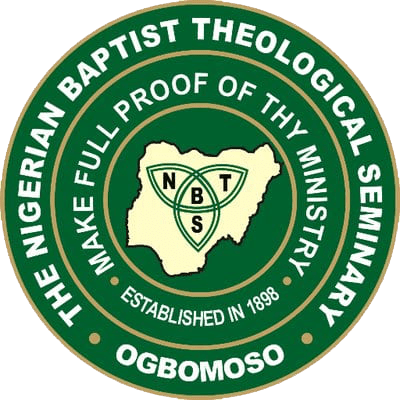Contextualization of Hymn in Service
Hymns play a significant role in Worship. It is a means of praise, adoration, thanksgiving, commitment and prayer, among others. Aside from the usual way of using hymns in worship service, selecting appropriate hymns can take care of a call to Worship, offertory prayer, thanksgiving prayer, benediction, and other elements of Worship. Since the hymn lyrics are bible-based, it is an excellent and valuable tool for Christian Worship. Worship is dynamic and not static; singing melody in place of verbalizing prayer creates a unique atmosphere in Christian Worship. But, as it is necessary to select an appropriate hymn, it is also important to assign the rightful leader to lead. Music ministers, choir directors, soloists, choir, musically trained pastors and deacons can also be engaged. Nigerian Baptist Convention is compiling a new hymn book for Christian Worship to have more indigenous hymns for Worship. The new hymn book will contain songs from indigenous writers not in the current Baptist hymnal inherited from the missionary.
Samples of Hymns for Elements of Worship
Call to Worship Hymns – “Breath on me, Breathe” (BH 167), “Come Holy Spirit” (BH169), “Spirit of the Living God” (BH 523), “The Lord is in His Holy Temple” (BH 515, 516)
Offertory Hymns – “All Things Are Thine” (BH 403)
Benediction Hymns – “Benediction” (BH 540), “God be with you” (BH372), “Grace, love, Peace abide” (BH 539)
Contributed by Solomon Tunde Ajayi.

Hymns for Baptism and the Lord’s Supper
Baptism is usually observed when some individuals have given their lives to Christ, and they are followed up with converts/believers class; after which arrangement is being done to baptize them in the name of the Lord Jesus. Baptism is a form of ritual purification – a characteristic of many religions throughout time and geography. In Christianity, it is a Christian sacrament of initiation and adoption, almost invariably with the use of water (Leverkuhn, 2022). The form that Baptism takes depends on each denomination, whether by sprinkling, infanthood or by immersion. Baptists and other evangelicals subscribe to baptism by immersion. In Baptist Churches, such sacred services are usually coupled with the Lord’s Supper; whereas some other churches observe separate services for Baptism and Lord’s Supper. It is this Lord’s Supper which some prefer to address as Holy Communion (Anglican, Methodist, Pentecostal, etc). The area of emphasis here is on the type of Hymns that are being used during such liturgies. The Hymns are such that are directly proclaiming the death, burial and resurrection of Christ; and the new life that it brings to a new believer in Him.
Such hymns include: “O Happy Day,” “Jesus Paid it All,” “There is a Fountain,” “Oh Jesus I Have Promised,” “Take My Life and Let it Be,” “Nothing But the Blood of Jesus,” “Have You Been to Jesus?,” “Power in the Blood,” “Brethren We Have Met to Worship,” “When I Survey the Wondrous Cross,” “At the Cross,” “The Old Rugged Cross,” among others. They are songs that connect the heart of the baptized with his/her Saviour and Redeemer, in warm love and appreciation of the great work of atonement which brings Salvation to the bearer. The singing of these reflective Hymns similarly helps to submerge every pride in human heart, enhance recommitment of growing believers to their Saviour; and restore the backslidden to the first love at Calvary.
Leverkuhn A. What is a Musical Idea? https://www.musicalexpert.org/what-is-a-musical-idea.htm Nov. 18, 2022 (musicalexpert.org) accessed 04/12/22.





Contributed by Victoria Oyenike Ayano.
Sabon Rai Music
Sabon Rai music can be well-defined as a Christian musical genre that it’s meant for spreading the message about Jesus Christ but not necessarily limited to that in practice. It may contain praise, thanksgiving, adoration of God, admonition, comfort, prayer social and moral values, and general Christian doctrines. The significance of Sabon Rai music among the Hausa-speaking Christians cannot be overemphasized. This is because it has been one of the major styles of Music that most of the Hausa-speaking churches use as a tool for mission and evangelism among the Hausas. Besides, other music singing groups usually minister during worship services.
Most of the churches prefer the Sabon Rai music to church praise teams because the instrumentation of it does not require electricity, more so that its instruments are not expensive. Sabon Rai music has unique patterns of dance. Sabon Rai dance though does not originate from any ethnic group, it contains a lot of Nigerian cultural elements, which makes it a good tool for evangelism. Sabon Rai dance has different powerful dance styles, the dancers dance like soldiers with so much energy and vigour. Sabon Rai music has played a role in mission and evangelism globally, it plays a better role in global mission especially in terms of propagating the gospel among the Hausa speaking communities.



Contributed by Daset Fwangshak Emmanuel.
African Church Music Band
African church music bands play a significant role in enriching worship and enhancing community connections. These bands often combine traditional African instruments, like drums, shakers, and xylophones, with modern instruments like keyboards, guitars, and drum kits. This blend creates a vibrant soundscape that reflects the cultural heritage of the congregants and appeals to a younger generation seeking a more engaging worship experience. Many African churches embrace this style to attract new members while retaining older members who appreciate the traditional sounds that feel uniquely African. The music often features call-and-response singing, polyrhythmic drumming, and layered harmonies, creating a worship experience that resonates deeply with congregants. Studies have shown that such music fosters a sense of unity and shared purpose, allowing worshippers to participate actively in worship rather than being passive listeners.
Furthermore, African church music bands have been found to strengthen the social fabric within the congregation. Members of the band often dedicate significant time to practice, which builds camaraderie and teamwork, and they are respected figures within the church community for their commitment. The diversity in the bands’ membership, often ranging from young adults to older musicians, creates an intergenerational bond where musical knowledge and spiritual values are shared and preserved. Research indicates that the church band setting helps foster leadership skills among younger members, as experienced musicians mentor them. Additionally, the band’s music frequently reflects biblical themes and messages that support church teachings, making the music both a form of worship and a medium for learning biblical principles.
Sources:
Kanu, Ikechukwu. “African Music in Christian Worship: Its Relevance and Impact on African Church Life.” African Theology Today, 2021.
Okeke, Chinwe. The Church Music Band as a Social Structure in Nigeria. Lagos: West African Press, 2019.
Adeyemo, T. Music and Worship in African Churches. Accra: African Christian Press, 2016.
Contributed by Chamberlain Eguono Oyibo.
Medleys
A medley in the context of worship music refers to a composition that combines multiple songs or musical pieces, often seamlessly transitioning from one to another. In Northern Nigerian churches, medleys hold significant importance for several reasons:
Cultural Expression
Medleys play a vital role in reflecting the diverse cultural landscape of Northern Nigeria. The region is home to various ethnic groups, each with its unique musical traditions and styles. By blending indigenous songs with contemporary Christian music, medleys create a worship atmosphere that honors local heritage. This fusion not only makes worship more relatable but also affirms the identity of the congregants, allowing them to express their faith through familiar cultural elements. For instance, incorporating traditional instruments or rhythms alongside gospel songs can enhance the worship experience, making it more vibrant and meaningful.
Engagement
Engagement is crucial in worship settings, and medleys are particularly effective in capturing the attention of congregants. When familiar tunes are used, congregants are more likely to participate—singing along, clapping, or dancing. This active involvement fosters a sense of community and shared experience, which is essential in a worship context. Medleys can also create a dynamic atmosphere, moving from reflective songs to more upbeat ones, encouraging congregants to respond emotionally and spiritually. This engagement is especially important in Northern Nigerian churches, where communal worship is a significant aspect of the faith experience.
Thematic Cohesion
Thematic cohesion in medleys allows worship leaders to convey specific spiritual messages or themes effectively. For example, a medley focused on themes of hope, praise, or thanksgiving can be constructed by selecting songs that reflect these ideas. This intentional structure helps guide the congregation through a journey of worship, reinforcing the message and encouraging deeper reflection. By carefully choosing songs that complement each other, worship leaders can create a powerful narrative that resonates with the congregation’s spiritual needs and enhances their worship experience.
Length Flexibility
In many Northern Nigerian churches, the duration of worship services can vary significantly. Medleys offer the flexibility to adjust the length of the musical segment without losing the essence of worship. Worship leaders can create shorter medleys for services with time constraints or longer ones for special occasions, such as festivals or celebrations. This adaptability ensures that worship remains impactful, allowing for a meaningful experience regardless of the time available. It also helps maintain the congregation’s focus, preventing services from becoming monotonous or overly lengthy.
Community Building
Medleys foster a sense of community among congregants. When people sing together, especially songs that resonate culturally and spiritually, it strengthens their bonds and creates a shared identity. This communal aspect is vital in Northern Nigerian churches, where community and fellowship are central to the faith experience. Medleys can also encourage collaboration among musicians and singers, promoting a sense of teamwork and unity within the church.
Spiritual Engagement
Ultimately, medleys enhance spiritual engagement by creating an environment conducive to worship and reflection. The seamless transitions between songs can evoke various emotions, guiding congregants through a range of spiritual experiences—from joy and celebration to introspection and reverence. This emotional journey can lead to a deeper connection with God, encouraging individuals to reflect on their faith and relationship with the divine.
Summarily, medleys are a powerful tool in worship music within Northern Nigerian churches. They serve as a bridge between cultural expression and spiritual engagement, fostering community, participation, and thematic depth in worship. By integrating diverse musical elements and familiar tunes, medleys enrich the worship experience, making it more relatable and impactful for congregants. Through this approach, churches can create an inclusive and vibrant atmosphere that resonates with the hearts of their members, ultimately enhancing their collective worship experience.
Contributed by Joshua Yero Kwasau.

